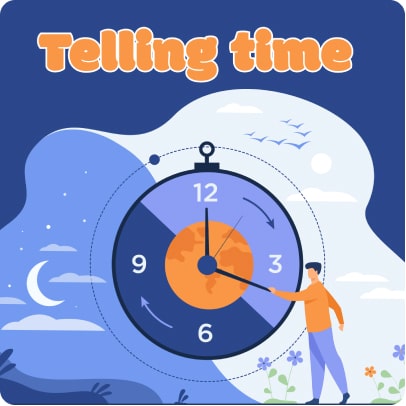
Many kids find it hard to learn how to tell the time. However, it is an important skill for a day to day life of children.
With our exciting approach and imaginative visuals, the young learners will become clock-reading pros in a short time.

It is always easy for adults to tell the time only with a glance at the clock. But it is much more difficult for kids to read the time, especially when they are still learning to develop their number sense. Certain memorizing combinations and math skills are required for the kids to properly read the clock.
With our engaging analog clock and reading techniques, kids will be able to practice their time-telling skills. Mastering analog clock-reading will help kids and students to be more independent and proficient at time management.
With Practithink, children find their way to proficiency by entertaining and interesting methods.

You may notice that the hour-hand is smaller as the steps between the hours are big and you will not mix the hours 2 and 3. And it is thicker as 1 hour is 60 times bigger than a minute.
The minute-hand is longer, as it points to the smaller value and if you want to tell the exact minute, you will need to check the hand that is close to the minute mark.
There are two hands in the clock showing the hour and the minute. The hour-hand is the small one that shows the hours at the clock.
The hand is at 2, which means that it is 2 o'clock. The second picture shows that the small hand is between the numbers 2 and 3, which means that it is still 2 o’clock. Keep in mind that the hour does not change as long as it is not pointed directly to the exact number.
The big hand is the minute-hand that shows the minutes at the clock.
It shows how much time has passed after the hour. However, if the minute-hand points at any number, you should multiply it by 5. Remember that there are 5 minutes between each of the numbers. So when the big hand is at 1, it means 5 minutes have passed. If it is at 2, 10 minutes have passed, etc. Now, let's have a look at the picture below and see what time it is.

In the first picture, you can see that the small hand is pointed at 12, so it’s 12 o’clock. The big hand shows 2, meaning that 10 minutes have passed. So the time at the first clock is “10 minutes passed 12”. Or you can just read as “twelve ten”.
The second picture shows that the small hand is between 1 and 2, meaning it is still 1 o’clock.
And the big hand points at 10. So the time is “50 minutes passed” 1 or just “one fifty”.
If we need to round the answers up to the nearest hour, we need to determine the “minute hand” (the bighand) position. If “minute hand” passes the 30-minute or 6-hour mark, then we round time up to the largest number. If the minute hand didn’t reach the 6-hour mark, we round the time to the lowest number.
Example: If you need to round the time to the nearest hour and the clock shows 3:25 you read 3 o’clock. If the clock shows 3:35, then you read 4 o’clock.

The closest half hour, quarter hour and minutes are determined by the number where “minute hand” points to.
A half hour has single position and it’s is when minute hand at 30 minutes or 6 hours. There are 2 positions for a quarter hour,
when minute hand points to 15 and 45 minutes or 3 and 9 hours

Your login was unsuccessful
New to Practithink? Create an account
Your login was unsuccessful
New to Practithink? Sign in here
Enter your email address below and we will send you instructions to reset your password.